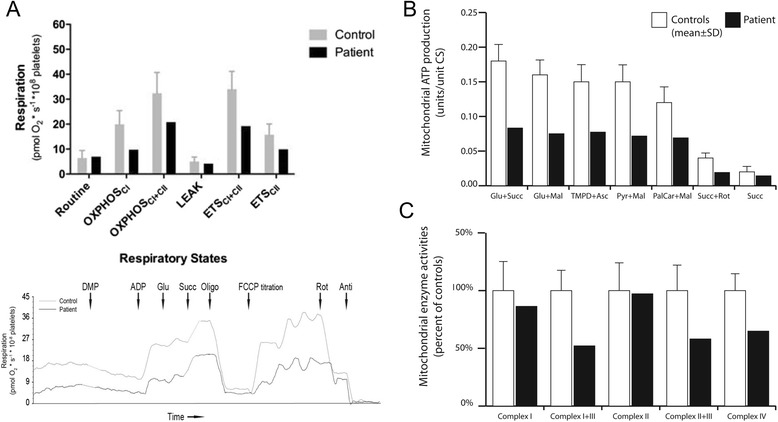Fig. 1.

Respirometry indicates mitochondrial disease. a Upper panel. Platelet mitochondrial respiration in patient and controls (n = 13; 1 month - 3 years; mean values ± SD). Respiration is expressed as pmol O2/s/108 platelets. Induced respiratory states and activated respiratory complexes are defined on x-axis. Routine, endogenous basal respiration of intact platelets; following cell membrane permeabilization: OXPHOSCI, phosphorylating respiration (OXPHOS) in presence of ADP and CI substrates (pyruvate, malate and glutamate); OXPHOSCI+CII, respiration in presence of ADP, CI and CII (succinate) substrates; LEAK, oligomycin-inhibited non-phosphorylating basal respiration (in presence of CI and CII substrates); ETSCI+CII, uncoupler (FCCP)-induced non-phosphorylating maximal capacity of the electron transport system (ETS); ETSCII, maximal non-phosphorylating CII-related respiration. Lower panel: representative traces of the substrate, uncoupler, inhibitor titration protocol of the patient platelets and one of the control samples. Consecutive additions of digitonin (for permeabilization) plus malate and pyruvate (DMP), ADP, glutamate (Glu), succinate (Succ), oligomycin (Oligo), uncoupler titration using FCCP, rotenone (Rot) and finally antimycin (Anti). b Muscle mitochondrial function in patient and controls (n = 11; 0–5 years; mean values ± SEM). Mitochondrial ATP production with the substrate combinations glutamate + succinate, glutamate + malate, TMPD + ascorbate, pyruvate + malate, palmitoyl-L-carnitine + malate, succinate + rotenone and succinate only. c Activities for the respiratory chain enzymes (NADH-coenzyme Q reductase (complex I), NADH-cytochrome c reductase (complex I + III), succinate dehydrogenase (complex II), succinate-cytochrome c reductase (complex I + III) and cytochrome c oxidase (complex IV). All activities are expressed relative to the controls. Mitochondrial ATP production and the respiratory chain enzyme activities were determined as units/unit citrate synthase activity in isolated mitochondria
